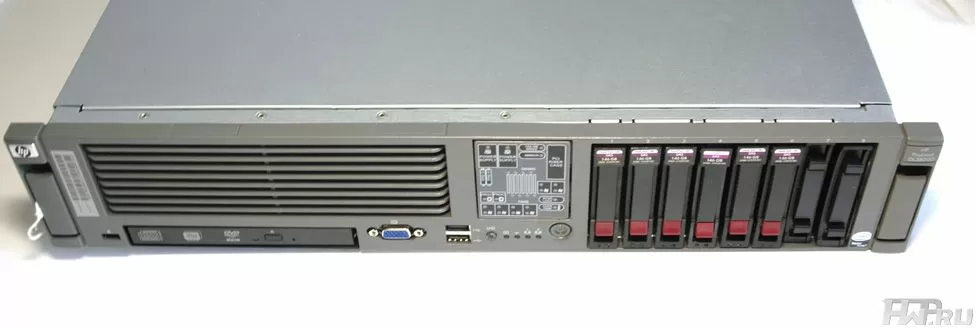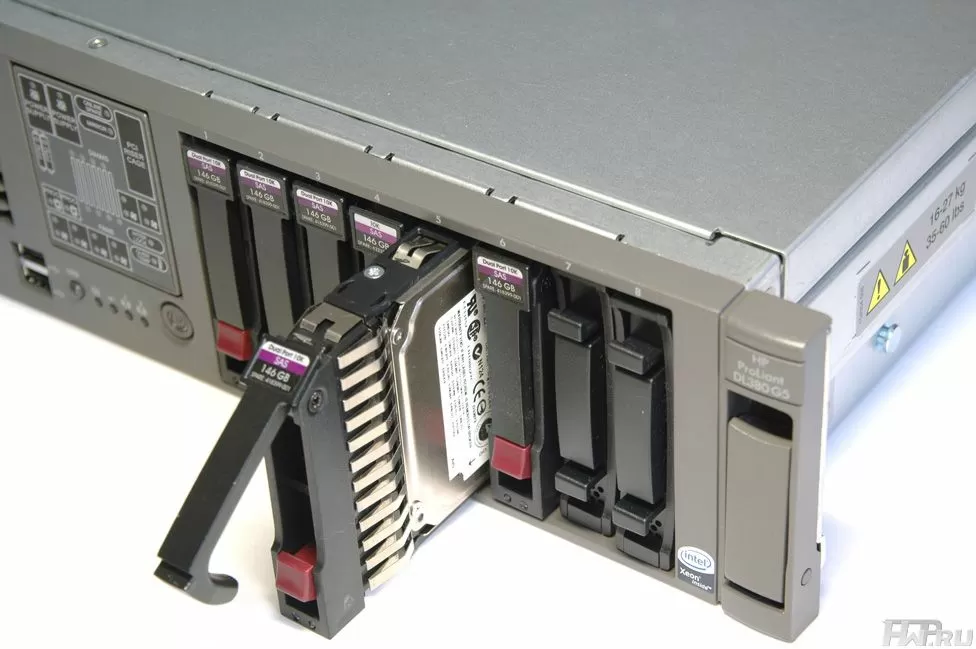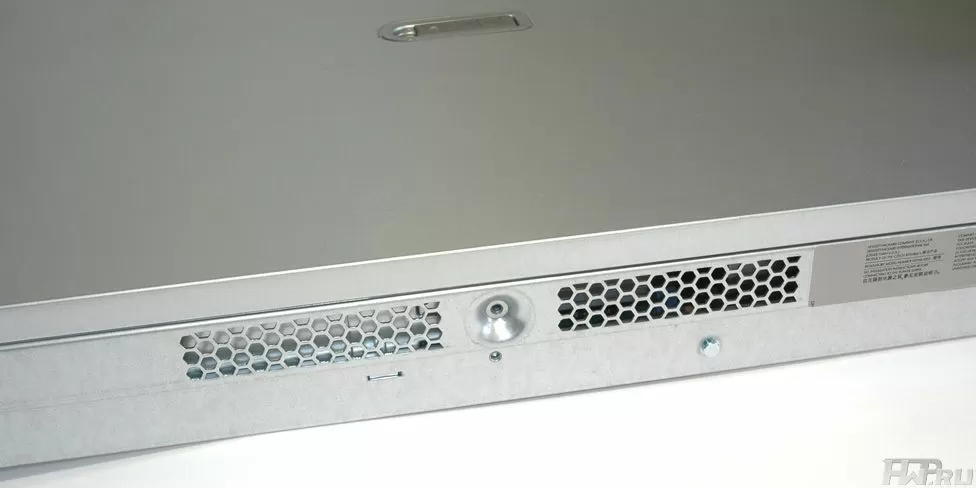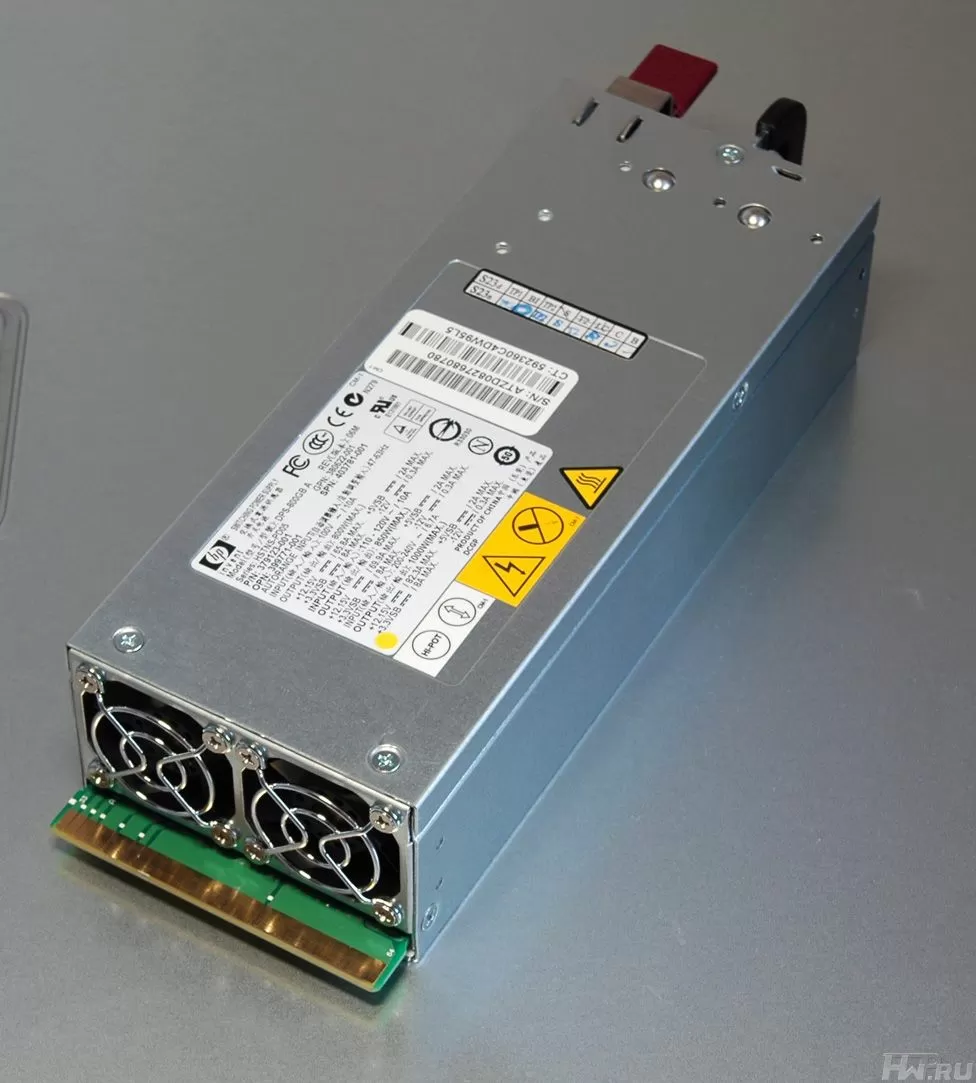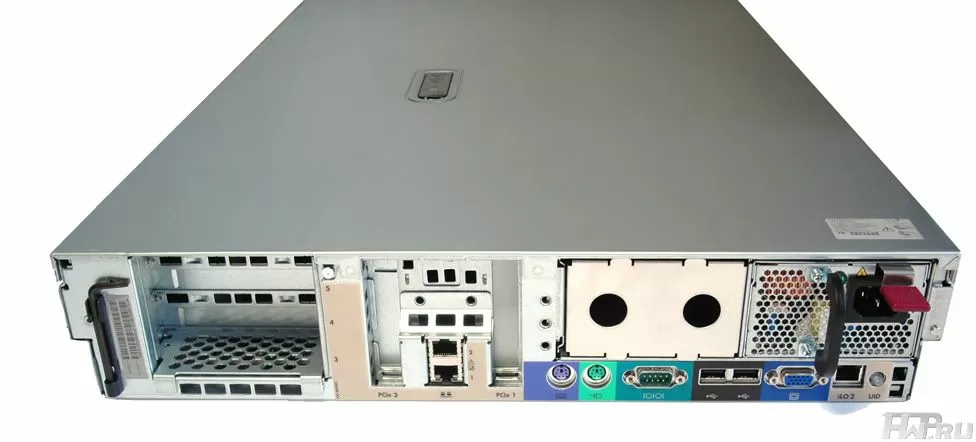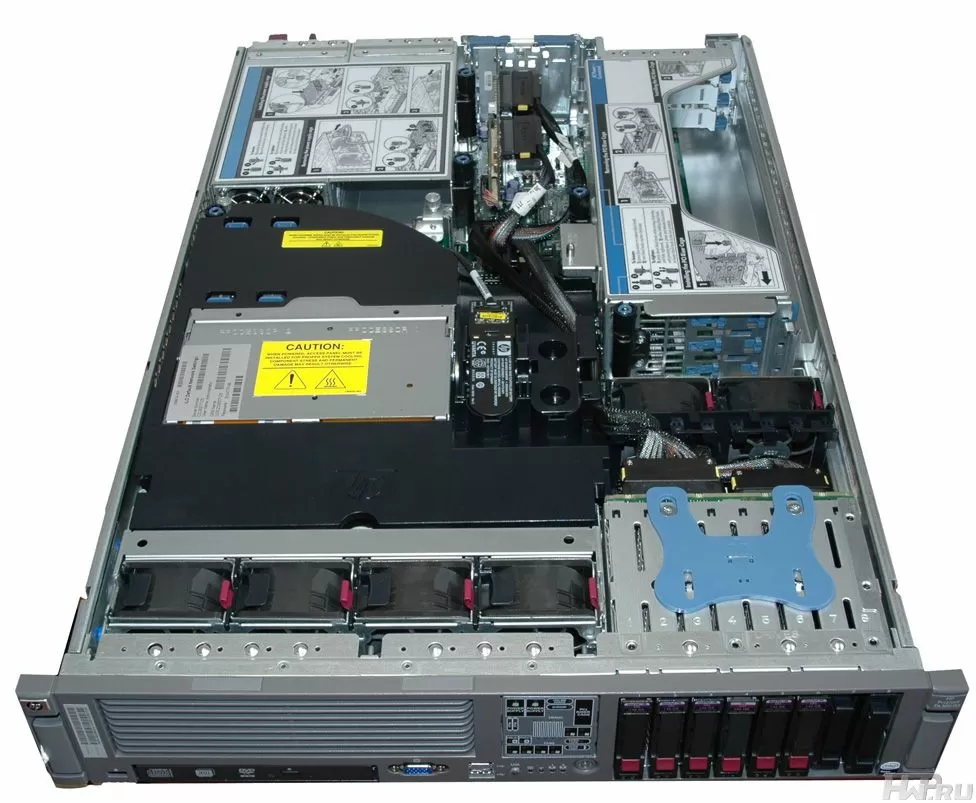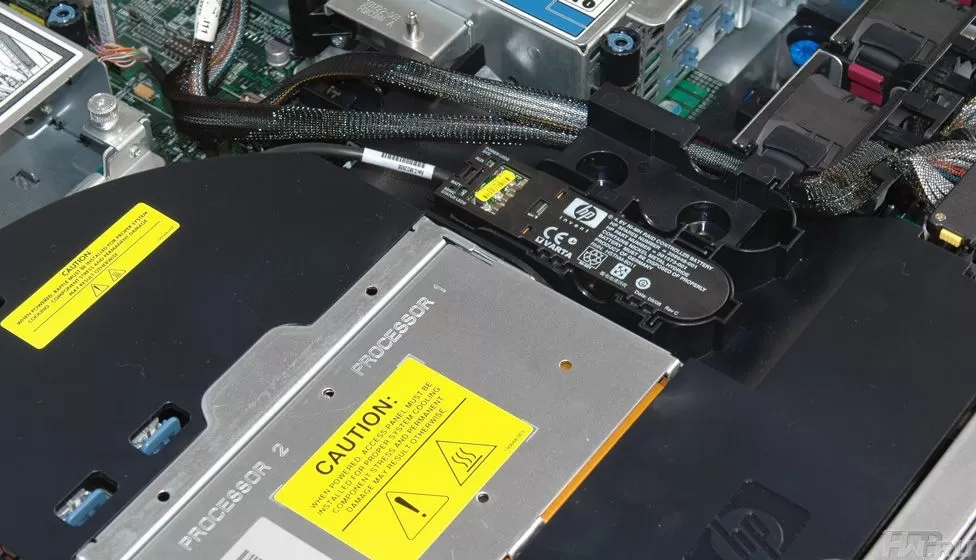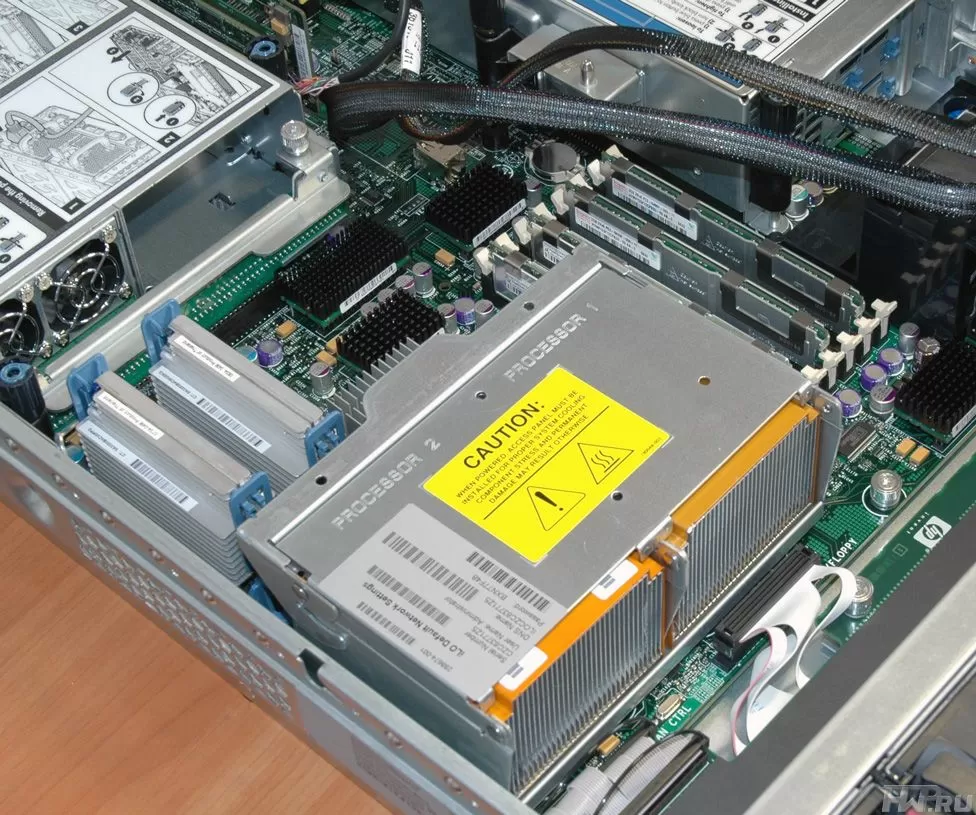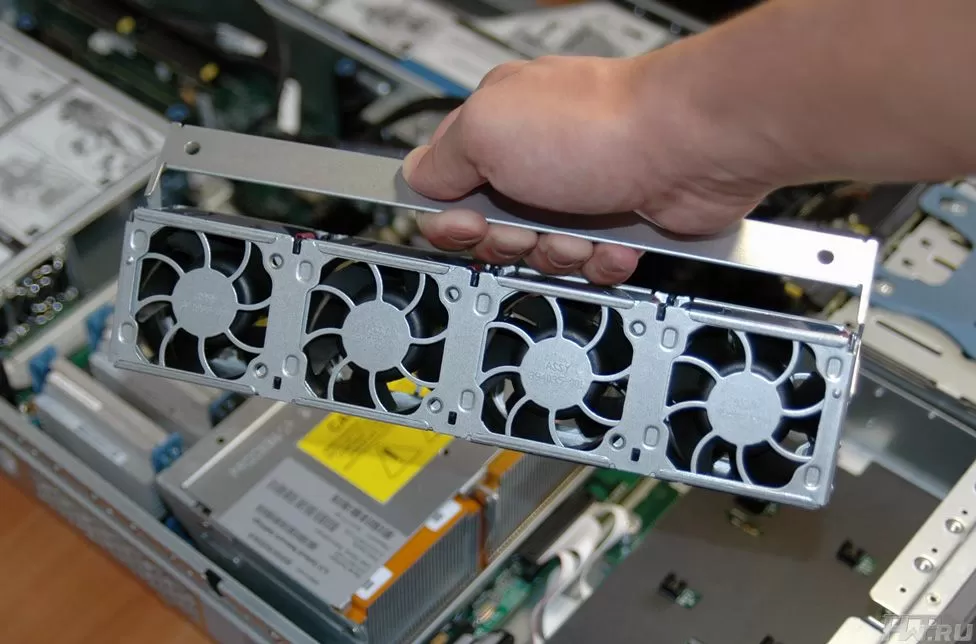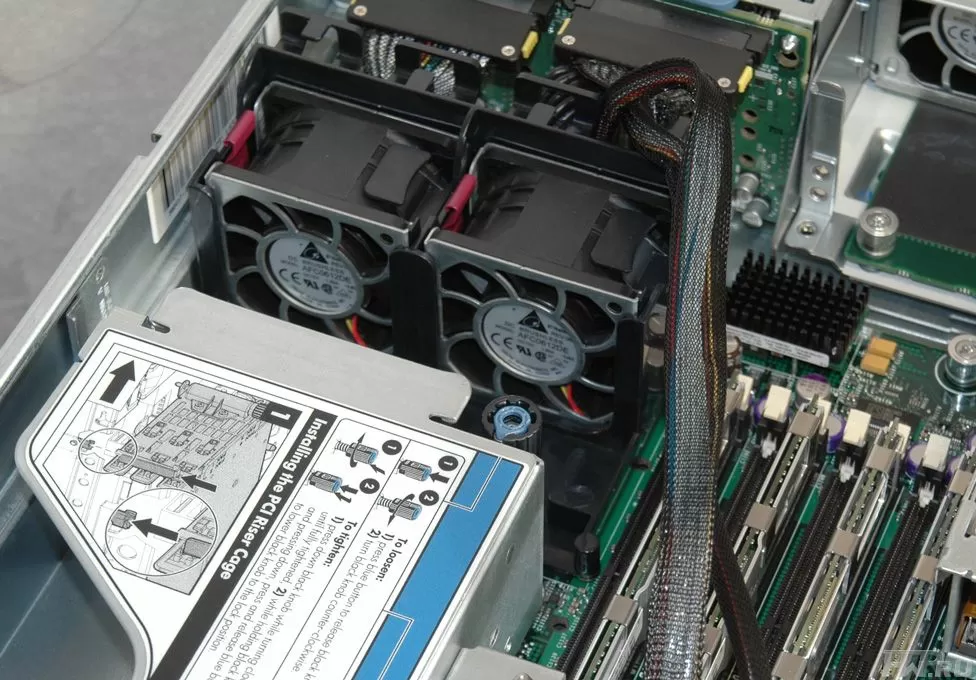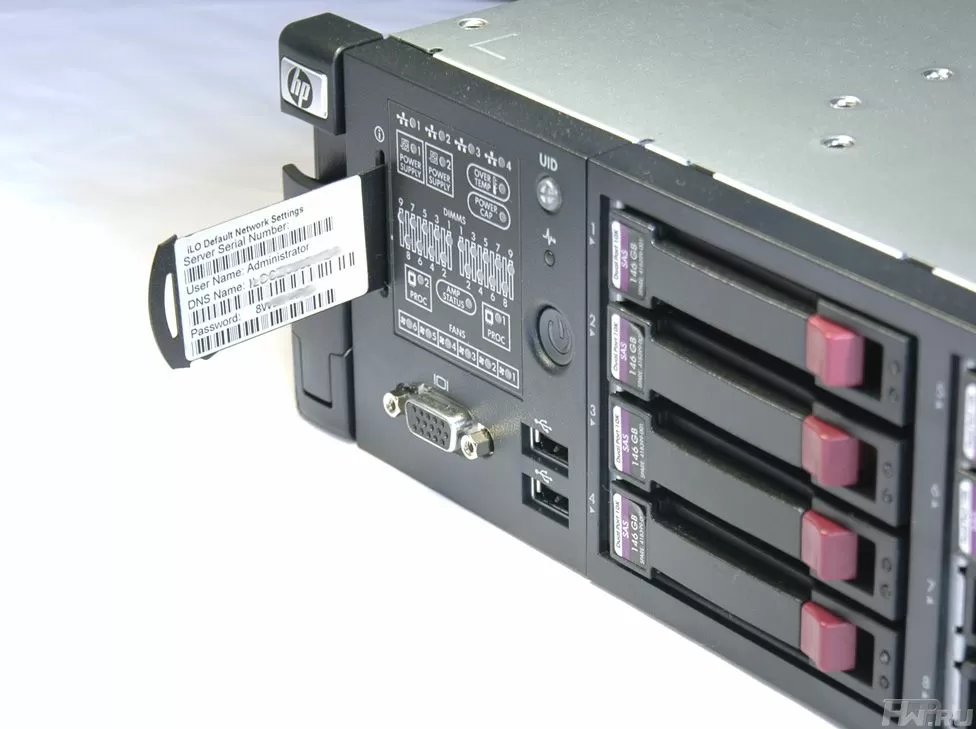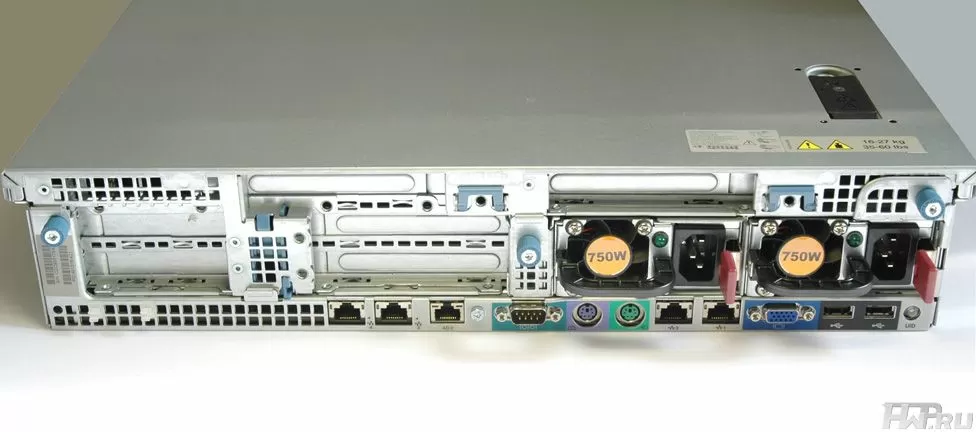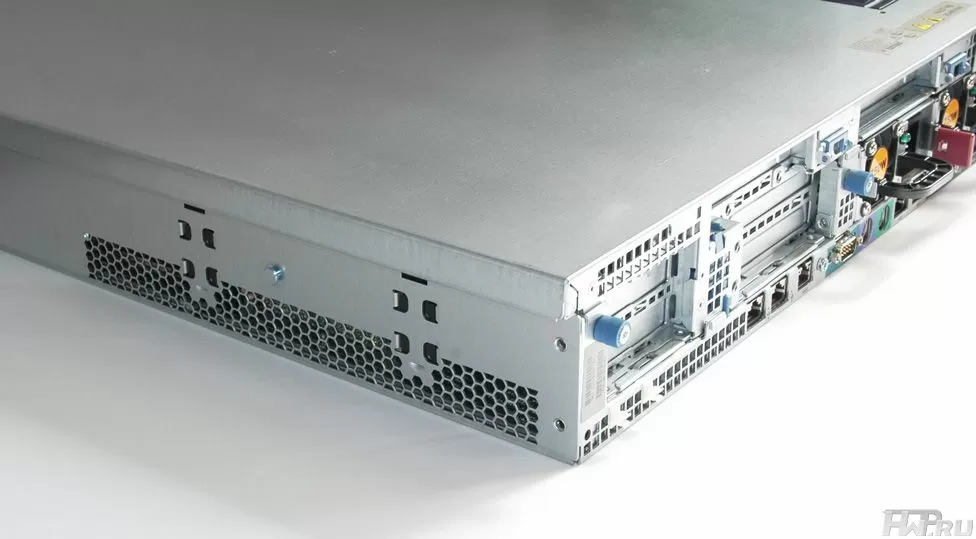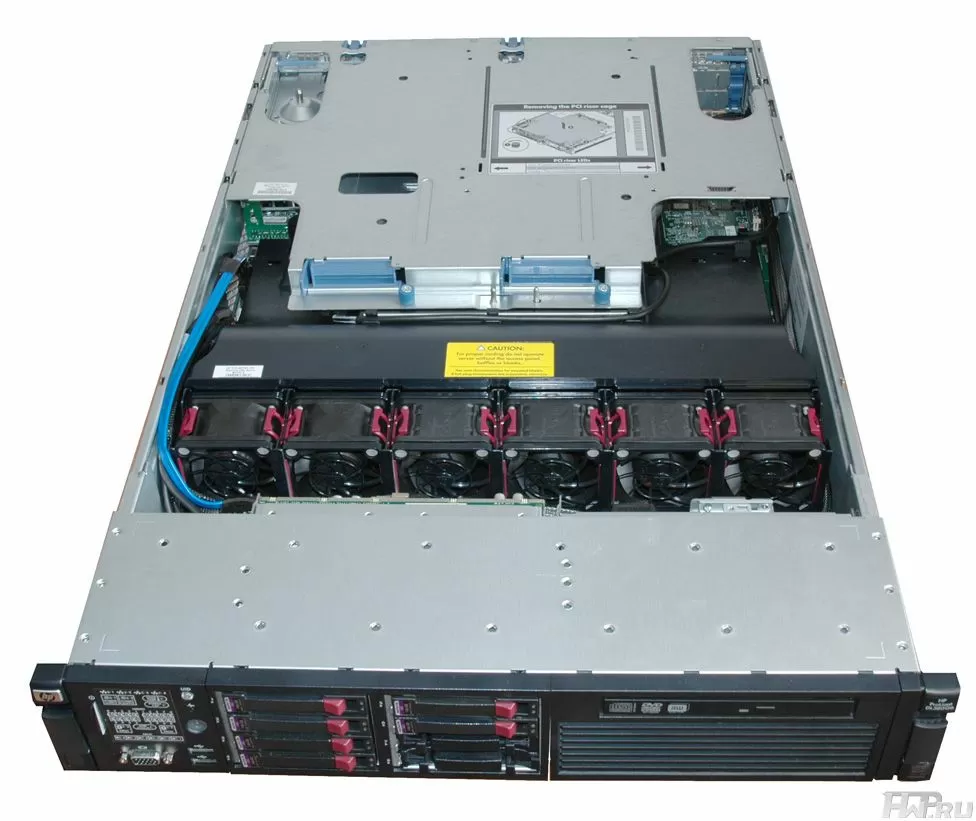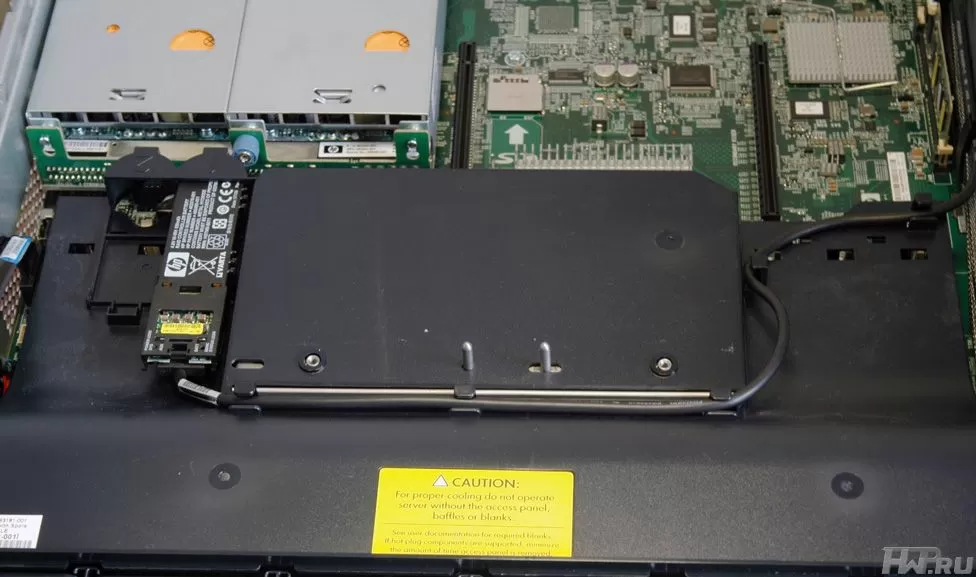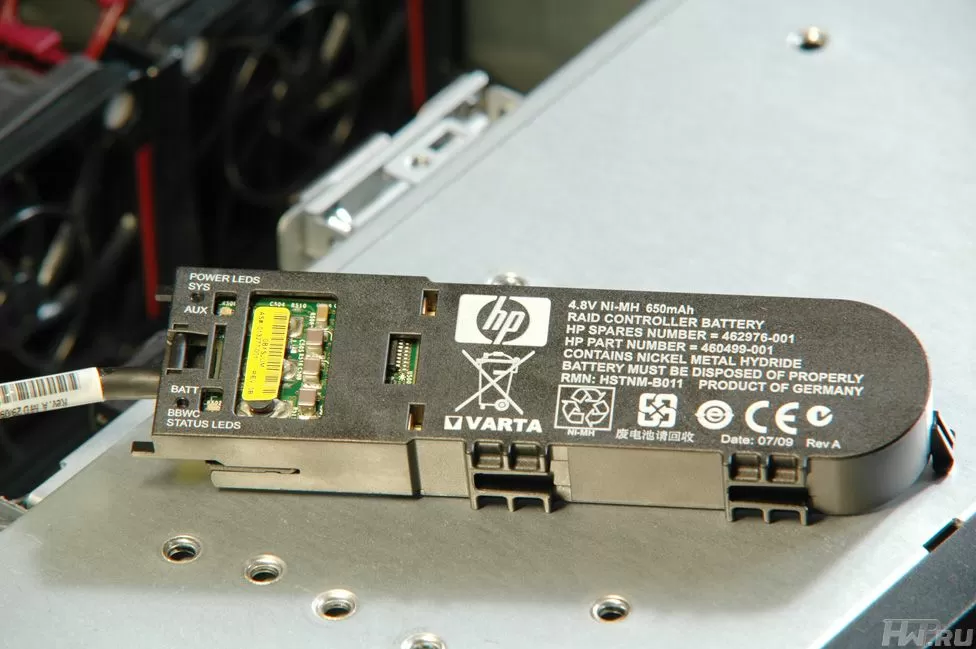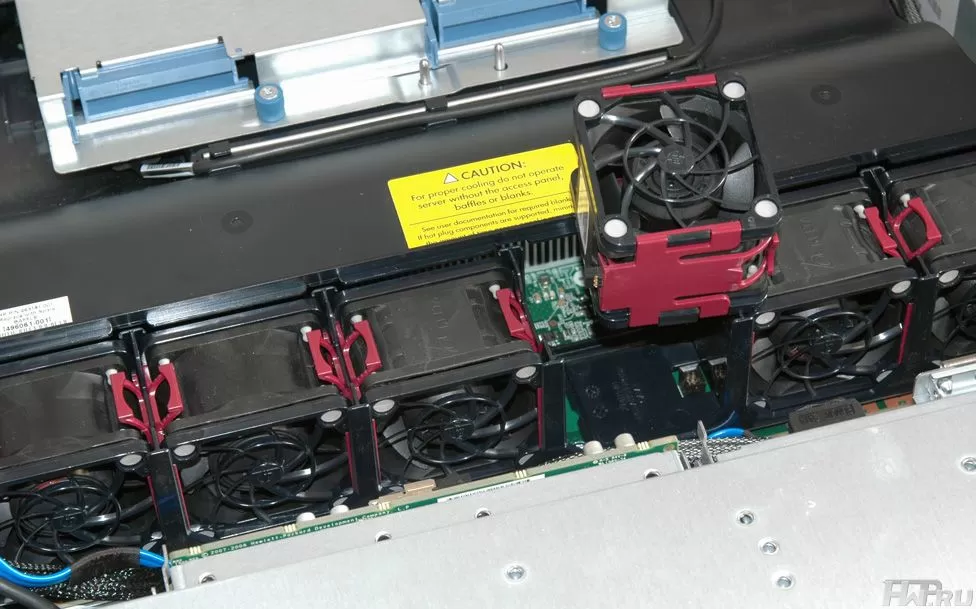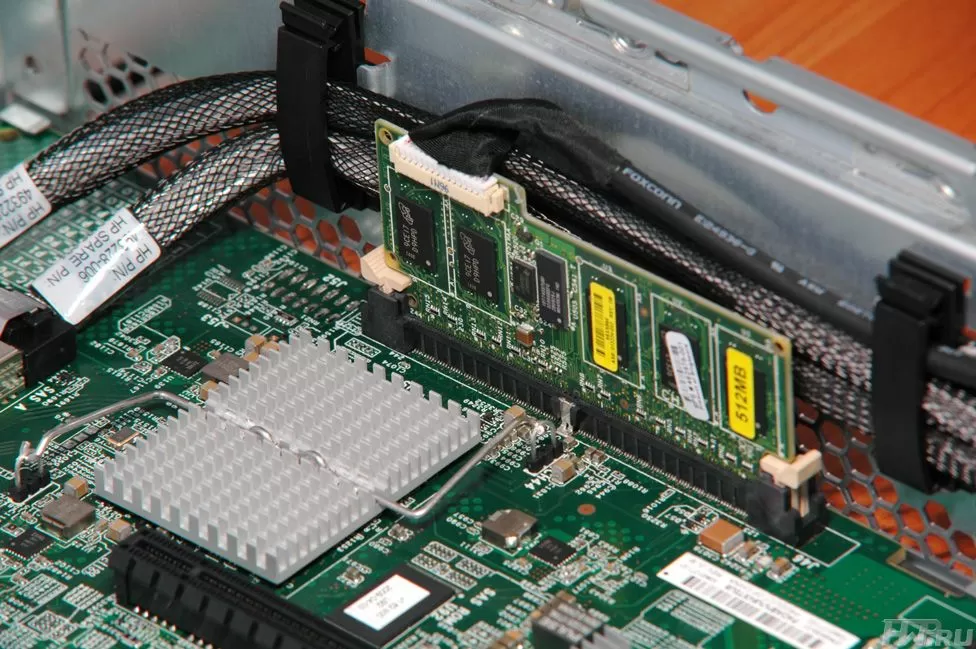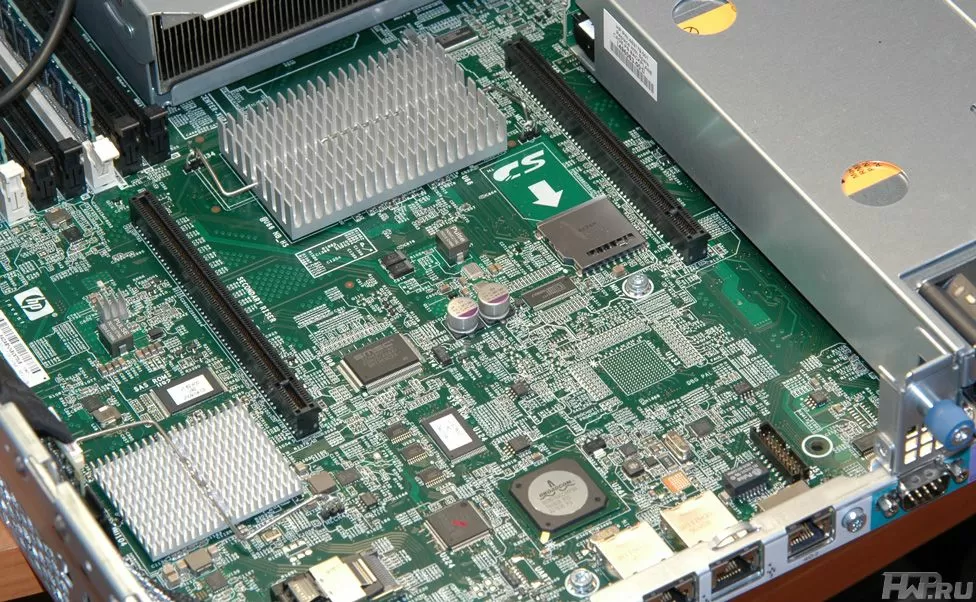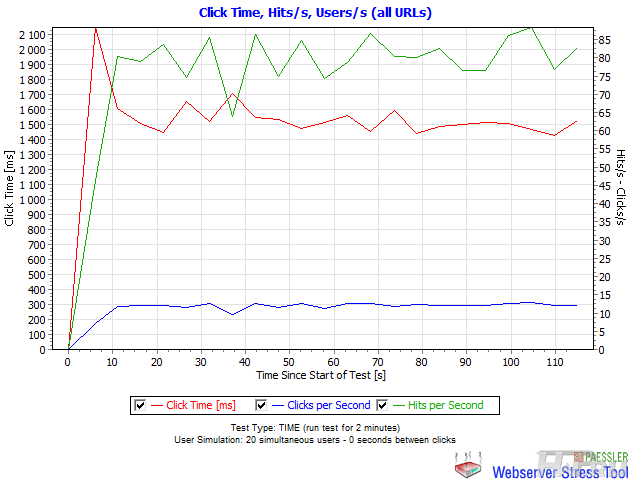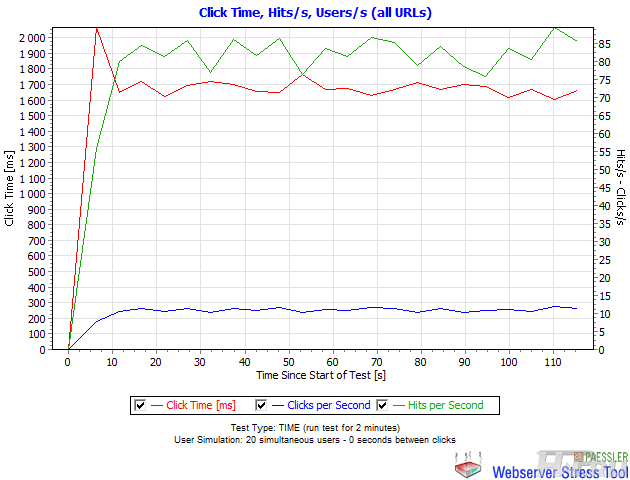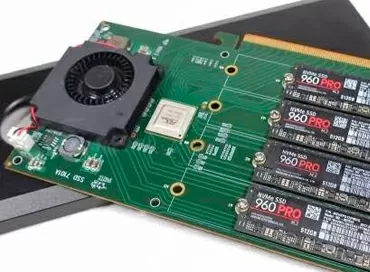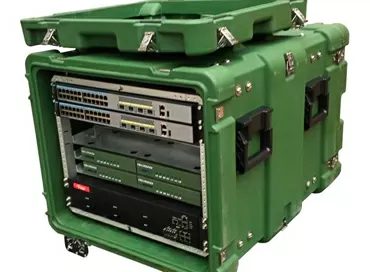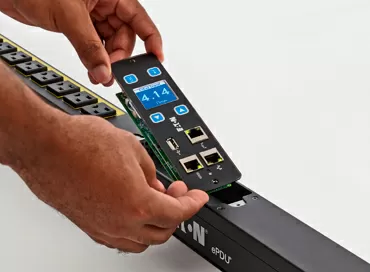Comparison of two HP ProLiant DL380 G5 and G6 series servers
Almost a year has passed since Intel presented its new Nehalem architecture on the server market, but at the same time, the previous generation processors based on the Harpertown core have not disappeared from the market, and therefore the question arises - What architecture should you choose when choosing a server? Intel maintains such an interesting pricing policy that for the price of the next generation Xeon processors you can get a good Xeon of the previous generation, and with a higher frequency.
Today we will look at two DL380 servers from Hewlett Packard, courtesy of Server-Unit. One - DL380 G5 , designed to install the previous generation Xeon 54xx processors, the other - DL380 G6 - to the most modern Xeon 55xx series based on Nehalem architecture (although today this model is being replaced by the latest server DL380 G7 ). By comparing them in terms of speed and design, we will be able to answer the main questions - is it worth overpaying for new processors and what speed increase you will get when replacing old servers with new ones.
HP ProLiant DL380 are versatile servers for small businesses and businesses. Assembled in rack 2U cases, they allow you to install up to 4 expansion cards with PCI Express/PCI-X interfaces for solving various tasks. Using up to 8 modern 2.5 "SAS hard drives, you can configure various configurations of RAID arrays to suit your needs. Top models are equipped with 2 Intel Xeon processors with a performance index of 50 or higher ( Xeon X545 0 or X5550 ). Hewlett Packard is positioning the DL380 series for use with everything from traditional large enterprise mail servers, web hosting and database servers, to cluster systems with increased availability and performance requirements. For example, for calculations of physical processes, modeling and content development. Losing to 1U models in compute density per unit, the DL380 is catching up in terms of the number of expansion cards and hard drives.
Naturally, a change in processor architecture is an excellent reason for a manufacturer to completely update their server. And modifications G5 and G6 differ not only in motherboards, as in other server manufacturers. For the DL380G6 , Hewlett Packard used a new chassis that was previously used in AMD servers. Let's start with the construction differences.
HP ProLiant DL380 G5
The server assembled in a 2U chassis turned out to be very heavy & ndash; about 22 Kg with hard drives. The case is quite rigid, and even if you raise it at one corner, there will not be even a hint of bending, as in some cheap servers. Well, in general, no one doubted it.
Let's look at the front panel of the server. Eight 2.5-inch hard drives are installed vertically in a row on the right side. Standard trays for SAS hard drives HP with hot swappable function have special stickers indicating the modification and capacity of the hard drive for easy replacement in case of failure. Above each of the hard drives, its serial number is indicated, but white on a gray background is not the best solution, especially for gloomy data centers. The vertical arrangement of disks is not very convenient if you need to quickly take out a disk and look at its markings directly on the hard drive. Unused HDD cages are covered with blanks.
To the left of the hard drives, in the central part of the front panel, there is a convenient indication of the status of the main server components. One glance at it is enough to understand if the power supplies, fans, memory modules and expansion cards are working, as well as whether there is overheating. Below it are additional indicators of the activity of network interfaces and the Power and UID buttons (light indication). There is no Reset button in the server, apparently HP thinks that their machines do not freeze, but in fact they are not, and the lack of Reset is a drawback!
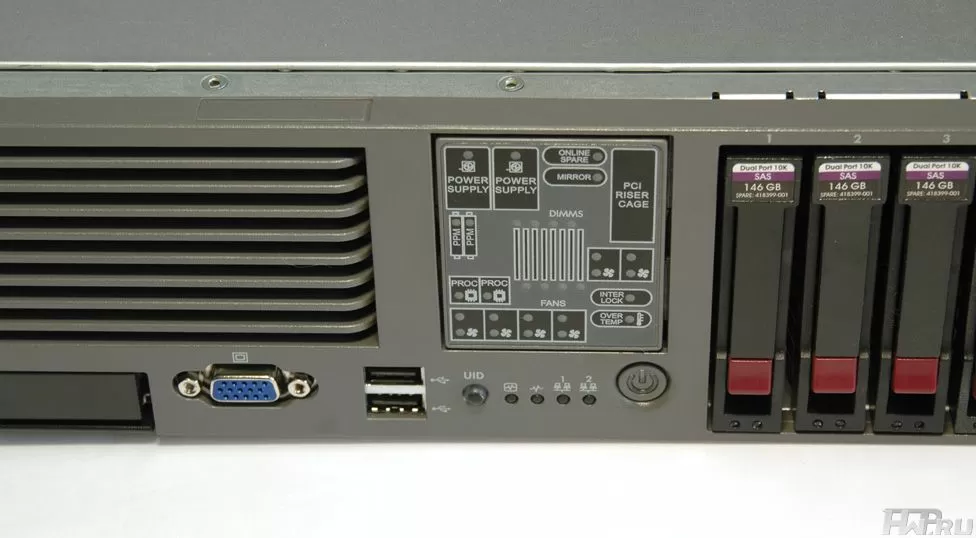
The left side of the bezel looks empty. Under a large ventilation grill, there is a slim form factor optical drive, two USB 2.0 ports and one VGA output. In general, HP DL380 servers have two integrated video cards, with two VGA outputs for convenient connection of KVM consoles, both from the front side and from the back. Folding handles are provided on the left and right for easy removal of the server from the rack. In principle, there is one serious reason to find fault with the front panel of the server - poorly readable inscriptions. Otherwise, everything meets corporate requirements.
The air is discharged mainly through the side ventilation grilles. The reason for this is quite simple - with all possible expansion cards installed, it will be difficult for fans to purge the case from the front panel to the back. However, we cannot say how justified this decision is when installing the machine in a server cabinet.
Depending on the modification, you can order HP ProLiant DL380 G5 servers with one or two 800W power supplies, providing sufficient redundancy to meet server availability requirements. Both power supplies are hot-swappable, PFC active and CE Mark compliant. On the back side there are PS/2 ports for keyboard and mouse, two USB 2.0 ports, VGA port, two network RJ45 and one RJ45 for the built-in iLO2 monitoring system.
HP ProLiant DL380 G5 has the ability to install two low-profile and three full-profile expansion cards. The first two are installed vertically directly into the motherboard connectors, the rest through a riser. ProLiant DL380 G5 server motherboards do not have an embedded hardware RAID controller , so if you select this controller in as an option (for example, HP Smart Array P400) - it will occupy one of the slots. Although, the remaining ones are more than enough for most situations. But let's see how the internal server space is organized.
Open the top cover, on the inside of which there are device layouts, and we get access to the server from the inside. Logically, the internal space is divided into several parts: the hottest area where processors, memory modules and chipsets are located, a cage with hard drives, a compartment for power supplies and a compartment for three expansion cards.
The hottest area is covered by a duct cover to better distribute airflow where it is needed most. This shroud has storage cable ducts and two battery slots for RAID controllers. The latter, thus, are always in easy accessibility, and in order to change a dead `` battery '', you do not have to remove the RAID controller - the whole process will take less than 5 minutes. By the way, Varta nickel-metal hydride batteries in this server are located right next to the processors and memory modules and are not blown by the air from the fans. Hopefully they are rated for high temperatures. Well, if not, they change very easily :).
Two processors are located in close proximity to each other and share a common heat sink mount. Next to the processors, there are 8 slots for FBDIMM memory modules. Behind the processors - a pair of VRM modules (Voltage Regulation Module), which provide voltage stabilization at increased loads. It seems as if HP engineers borrowed the idea of VRM modules from Gigabyte with its boards for overclockers. Not only do the modules have massive radiators that interfere with the air flow, but they also give the impression of some kind of unreliable design. Otherwise they would not be replaceable.
There is one internal USB port on the board, obviously for booting the system from a flash drive. In cluster systems, as well as where you need all the space of the disk system (for example, when using a server as a NAS), this feature will be relevant.
Let's talk about the cooling system. To efficiently blow air through the server, 6 60x60x40 mm fans are used, and 2 more 40x40x20 fans on each of the power supplies. The main fans manufactured by Delta Electronics have a maximum power of 21.6 W and are electronically controlled. 4 of these system fans are combined into a processor and electronics cooling unit. This block can be easily removed and replaced with the same one, or it can be rearranged closer to the processors, or even put two such blocks in series for better cooling. Each of the fans has an easy replacement function. Made in the form of cartridges, they eliminate the need to manually connect wiring. The fans have one impeller, no means of vibration reduction are provided.
Two more fans cool the hard drive cage and expansion cards installed in the riser bay. This bay contains a riser card for two PCI Express 8x and one PCI Express 4x ports and a chassis for stiffness and airflow.
It's a pity that a good air flow through the boards in the compartment can not be expected - on the side of the fans the riser has a grill with rather rare sections, and throughout the entire compartment for these boards, there is a ventilation lattice. The stream will exit the chassis before it reaches the start of the expansion card. Another drawback of the riser is the difficulty of installing cards with internal cables, such as RAID controllers. The fact is that there are no holes for such loops and cables on the back of the riser box.
All elements within the server are available without tools. True, to access the expansion cards installed in the riser, you need an asterisk key (you can unscrew it by hand, but the key is more convenient). This key can be found on the back panel outside the server.
As already mentioned, you can optionally install a HP SmartArray P400 RAID controller on the server. This card fits into a low-profile PCI Express 4x slot and allows you to connect all 8 hard drives. The controller is built on a 500 MHz LSI Logic LSISAS1078 processor and can be upgraded with 512 MB of DDR II 667 MHz memory. The controller has hardware support for RAID 5 and RAID6. In some modifications, the controller can be integrated into the motherboard.
This controller supports up to 16 disks, the speed is up to 300 Mb/s (SAS 3Gbps, SATA-1.5 Gbps) per one physical connection, arrays of more than 2 TB, and when all eight hard drives are connected, the manufacturer promises speed - up to 2 Gb/s on the array. True, by modern standards, the controller processor is, of course, rather weak. Nevertheless, most of the demanded functions are supported - RAID Migration, stripe size migration, array and logical disk expansion, online BIOS flashing. But there is no Snapshot function.
2.5 "drives are shipped pre-installed in trays. The latter are mounted in the basket using vibration damping spring elements. The indication of each disc is bright and clearly visible. There is no stray light from neighboring hard drives. Tray latches are durable and convenient - everyone would like it.
Two network ports are controlled by BroadCom NexXtreme II BCM5708 controllers connected via PCI Express 4x bus. This controller has Accelerated iSCSI support, for which you will have to purchase a license key
Another feature of the HP ProLiant DL380 G5 server appears when it is turned on. The server vibrates a lot due to its fans. Large and powerful, they have no protection against vibration, and when the electronics drive them at an increased speed, the vibration is very strong. At the minimum speed, the server is quite loud, so in the office it is better to install it away from the working staff. The motherboard BIOS does not allow changing the fan speed profile. In our configuration, in idle mode, the server consumed about 270W . When tested - up to 400W .
I must say right away that within the framework of this article we will not touch upon BIOS settings, as well as remote monitoring and configuration functions, since they are practically identical for both servers, and there is enough information on them on the manufacturer's website. We'd better move on to the second server immediately, the HP DL380G6.
HP ProLiant DL380 G6
If the DL380 G5 server was thought out by its server design, then the DL380 G6 is a masterpiece . Modern requirements for low power consumption, high server availability, as well as previous experience forced the developers to think it over to the smallest detail. First of all, outwardly the server looks more presentable. The gray front panel, reminiscent of the VAZ dashboard, gave way to a black one made of better quality plastic. Now the labels are better visible, and the layout of the front panel has become more convenient.
Hard disks are now arranged horizontally, in two columns, slightly off-center to the left. Optionally, you can order a basket that will allow you to install up to 16 SFF (2.5 ") hard drives into the server. The optical drive is moved to the top, and the server display panel along with ports and buttons is to the left. Now it also has LEDs that show the status of the network. VGA output, a pair of USB ports, on/off button and UID indication remained unchanged, and there is still no Reset. But to the left of them a tag appeared with the parameters of access to the iLO remote monitoring system. By the way, on the DL380 G5, such a tag was hung on a string, like a price tag on a bag of sugar.
Unlike its predecessor, the HP DL380 G6 can have up to 4 network ports, plus one RJ45 iLO 2 monitoring port. Likewise, there are two PS/2 ports, two USB 2.0 ports, a second VGA output and an RS-232 port available for rear KVM connections.
Our configuration included a redundant 750 W power supply unit, consisting of two hot-swappable modules. HP claims 80Plus Gold certification for these PSUs and is 92% efficient . DL380 G6 supports up to 6 expansion cards with PCI Express interface, two are low-profile, the other four are full-profile. As in the DL380 G6 , here cooling is carried out by drawing in air through the front panel and exhausting it through the ventilation grilles in the side walls of the case. However, the back of the case also has more air vents, so the case is definitely easier to blow through in length than the G5. But let's take a look inside the server.
Yes, the first impression of the design is confirmed here too - the chassis really became more literate. The body is divided across zones, and it has become more comfortable. However, there are some peculiarities. For example, the case with risers is now the same for all expansion cards, and in order to access something inside the server (except for the fans), you first have to remove the riser with all expansion cards. Even to replace the battery of the RAID controller. Each of the risers has a status LED. Conveniently, to be sure that the riser board is fully inserted into the corresponding connector on the motherboard, power is supplied to it - and everything is fine. It is difficult to say for sure whether it is good or bad to have such a riser that must be removed first if you need something in the server. He obviously does not add service speed. However, the riser in the DL380 G6 no longer interferes with installing the boards to which the cables are connected. And for long cards installed in the upper bays, there are latches on the back.
Optionally, you can purchase a server with risers that have PCI Express 4x, 8x, and even 16x slots, as well as PCI-X 133 MHz. However, there are no cables for connecting G-GPU cards like nVidia Tesla 1060.
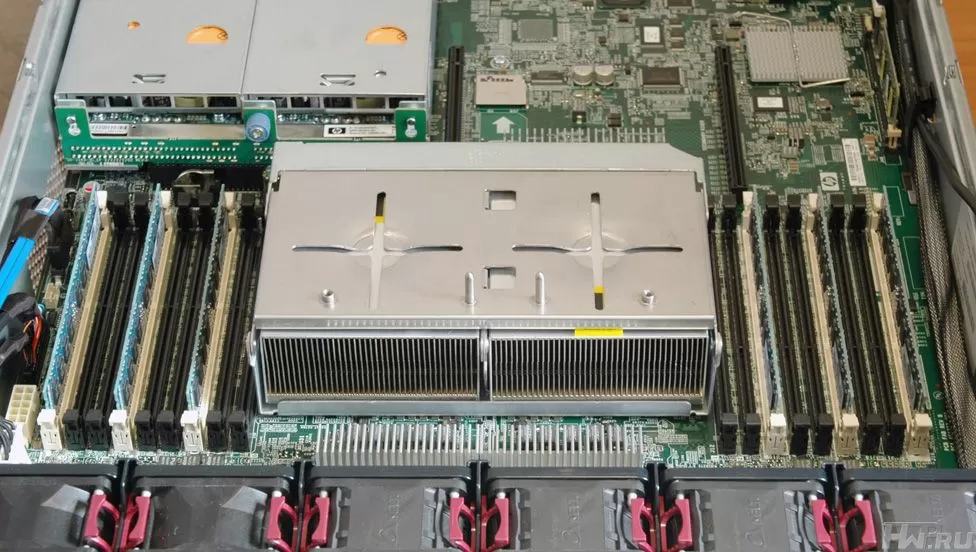
Since the Nehalem architecture requires FBDIMM slots to be set individually for each processor, naturally, they take up more space here. There are 18 memory slots available, 9 for each processor. The total amount of installed memory is up to 192 GB . Hewlett Packard engineers decided to arrange processor sockets and memory slots in a row so that they take up the entire width of the motherboard and allow the entire server airflow to pass through.
From above, this part of the motherboard is covered with a massive plastic casing, which, like DL380 G5 , has slots for two batteries of the RAID controller, also "lying" above the DIMMs and not cooled by air. The only thing is that now their cable is more conveniently routed over the casing. But - only one cable from one battery. Install a second battery for the second RAID controller and you will pull the power cable as needed. The HP SmartArray 410i RAID controller uses the same Varta battery as the SmartArray 400p.
Compared to the motherboard used in the ProLiant DL380 G5 , it looks modern here. No replaceable VRM modules for you - all power elements are built into the motherboard, and the hottest ones are located between the processors and fans. And there are much fewer visually small radiators here. As already mentioned, the processors are located in the middle of the motherboard. Mounting of radiators is the same as for ProLiant DL380 G5. Power cables and SAS cables are routed along the side walls of the case, very neat, nothing sticks out, and therefore does not interfere with cooling.
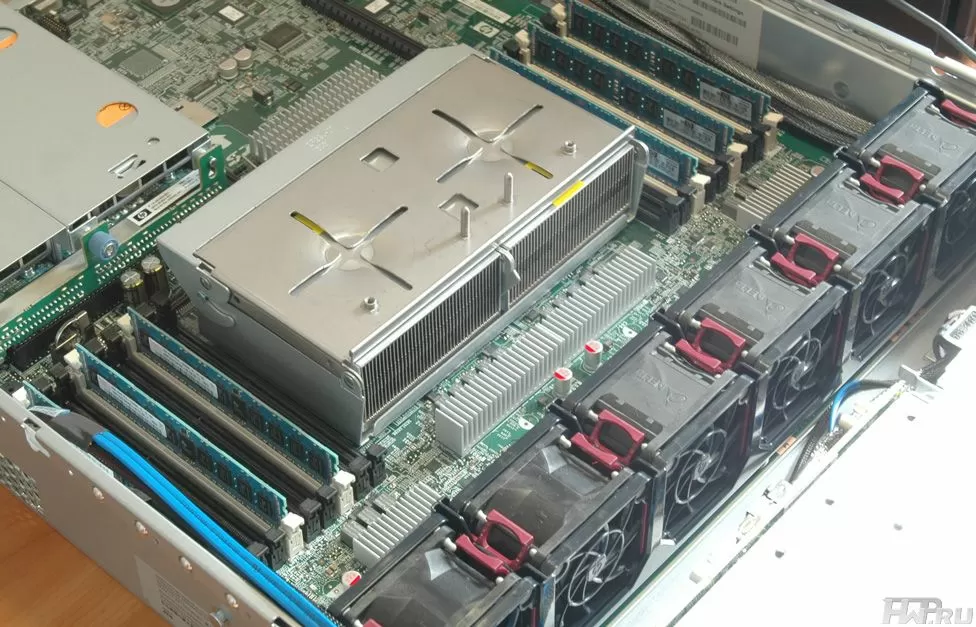
Let's talk about cooling. The HP ProLiant DL380 G6 server uses 6 60x60x40 mm fans, plus 2 40x40x20 mm fans in each of the power supplies. The system fans have an easy-to-replace function; instead of a metal grill, they use a thinner plastic one. Each fan, manufactured by Delta Electronics, has a single impeller, but it is literally suspended from rubber feet to prevent vibration propagation. As a result, the case never vibrates from the fans! Even when they start at maximum speed, there is absolutely no vibration. The enclosure space is dimensioned to provide minimum air resistance at both inlet and outlet. As a result, running ahead, I will say that in normal mode the server works very quietly, comparable in volume to a normal desktop computer! Thanks to Hewlett Packard for a quiet server!
Interestingly, in DL380 G6 you can replace even an optical drive in just a minute, without tools. The Serial ATA interface makes it easy to pick up a new DVD-RW should the need arise. By the way, DL380 G5 also has a function to hot swap DVD-RW drive .
HP DL380 G6 servers are equipped with HP Smart Array P410i integrated hardware SAS RAID controllers. Depending on the server modification, they can have no cache memory at all, have 256 MB of 40-bit DDR2-800 memory with or without a battery, or 512 MB of 72-bit DDR-800 memory with a battery. This controller supports SAS 6 Gbps, SATA 3 Gbps, and is connected via PCI Express 8x with up to 4 Gb/s bus bandwidth. RAID 5 support is available only on models with a battery-protected cache memory of 256MB or greater . But for support for RAID 6 and RAID 6 + 0, you will also have to fork out for the Smart Array Advanced Pack License, that is, a license key with 24x7 technical support - about $ 370 . A full-fledged RAID controller with support for RAID 6 costs about the same, in which no licenses are required.
The HP DL380 G6 server motherboard has one internal USB 2.0 port and one SD card slot from which you can boot the operating system. Two two-port BroadCom PCM5709C with PCI Express 4x interface, having hardware iSCSI accelerator , as well as CIFS and NFS protocols, support for load balancing and aggregation are used as network controllers. No activation or licensing is required to use these features.
During testing, the server showed the following power consumption values: 230 W in idle mode and 380 W in maximum load mode.
In general, the DL380 G6 server has really grown a head compared to the G5, and this does not even concern the new architecture of Nehalem processors, but the technologies used. On the one hand, it's nice that you don't have to buy a license to implement the iSCSI accelerator, on the other hand, you still need a license for RAID 6. But enough talk, let's get down to business, namely, testing servers.
Testing
The following servers were used for testing:
|
HP ProLiant DL380 G5 |
HP ProLiant DL380 G6 491316-421 |
|
2x Xeon X5450 QC, 3.0 GHz, 1333 MHz FSB, 12 Mb L2 |
2 x Xeon X5550 QC, HT, 2.6 GHz, 8 Mb L3 |
|
12 Gb PC2-5300 Fully Buffered DIMM |
12 Gb PC3-10600 ECC Unbuffered |
|
HP SmartArray P400, 512Mb, BBU |
HP SmartArray P410i, 512Mb, BBU |
|
6xHDD HP SAS-3Gbps, 10K RPM 146 Gb Dual Port, RAID 1 + 0, RAID 5 |
6xHDD HP SAS-3Gbps, 10K RPM 146 Gb Dual Port, RAID 1 + 0, RAID 5 |
|
MS Windows Server 2008 |
MS Windows Server 2008 |
BIOS power saving settings have been set to HP Optimal Performance. Although the processors are of different frequencies, they are in the same performance class, according to Intel and the competing price.
SPEC ViewPerf 10.0 - No Threads
The first test - performance in old applications was carried out without using multithreading. This test allows you to evaluate performance in a single CAD window. And although no one has been working in CAD for a long time without a good graphics card, we can judge the advantages of the new Nehalem processor architecture.
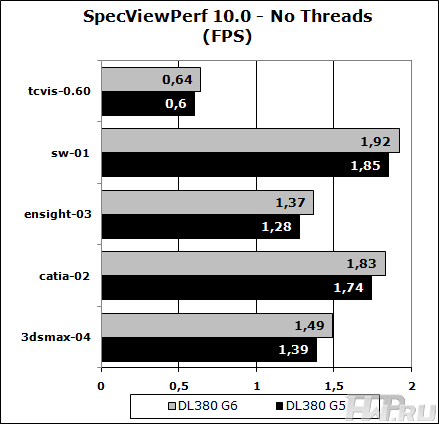
There is an advantage of the new architecture, but extremely low. Generally it is a waste of not multitasking on modern machines.
CineBench3D R10 x64
This DCC application is already using multithreading to render scenes.
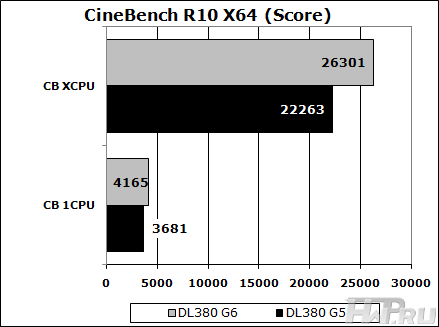
But the advantage of the new server over the old one is not very high, although it is obvious. Obviously, the high load on the processor ALU neutralizes the presence of HyperThreading technology, and the memory is no longer used as actively.
SPEC JVM2008 BASE
This JAVA application speed test already uses multitasking. It was started with standard parameters, except for the Heap Size value, which had to be increased from the standard 400 MB to 2400 MB, otherwise on 16 DL380 G6 cores (using HyperThreading) an out of memory error was generated.
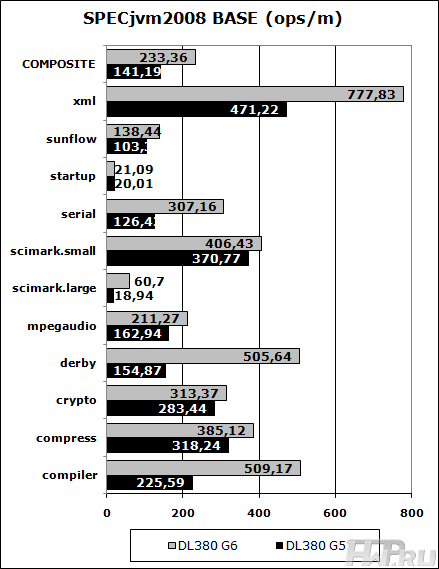
I think comments are unnecessary here - a clear superiority, almost 2 times in the overall standings, up to 3 times in individual tests.
MСS Benchmark
The superiority of the new processors in multitasking applications is indirectly confirmed by MCS Benchmark.

Superiority is neither more nor less - 2.5 times! But do not forget that MCS Benchmark is pure synthetics, and it may not reflect the real situation.
SiSoft Sandra 2009
Another synthetic processor benchmark.
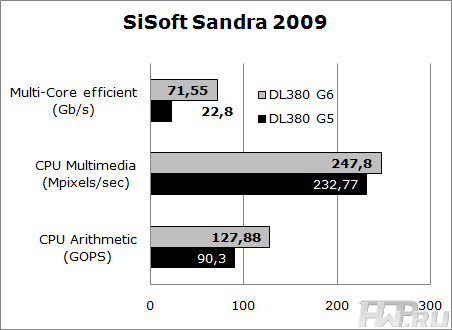
The same situation. Let's move on to the Real-world test.
1C-Bitrix: Corporate Portal 8.0.7
The next test is the speed of machines working as web servers. We decided to install the most famous Russian CMS on Windows Server 2008, corporate portal editions . An installer was downloaded from the manufacturer's website, which included Bitrix Environment version 1.3:
-
MySQL 5.0.51
-
Apache 2.2.8
-
PHP 5.2.6
-
Zend Optimizer 3.3.0
-
eAccelerator 0.9.5
Having installed the site with the default settings in the database with Win-1251 encoding, we were able to use Paessler Webserver Stress Tool 7 to emulate the load on the server. There was a problem. The fact is that with a really heavy load of 100 simultaneous connections, Apache hung on the server, which did not allow squeezing the maximum out of the servers. Perhaps fine-tuning the system would help prevent this, but setting up a server for Bitrix is the task of system administrators. To get consistent results, we used 20 concurrent connections running for 2 minutes with zero latency between sessions and 58 "corporate portal" URLs.
According to the graphs of hits per second and clicks per second, we can say that both servers performed equally. But according to Click Time, the time that the user waits from the moment of clicking until the moment when the download is completed, the DL380G6 shows itself a little better. But in general, on a simple database, for PHP sites with a simple structure, both servers performed the same. And if it hadn't been for the buggy Apache, they'd have processed 7,344,000 hits each in an hour - a huge value.
IOMeter
We tested the speed of the disk array RAID 5 , created on three hard drives. We were more interested not in the speed of the disk subsystem as a whole, but in the speed of the controller. The tests were carried out on the NTFS file system. The first test for the number of operations with random access was carried out with a block size of 8192 bytes. The percentage of write operations changed sequentially from 0 to 100%.
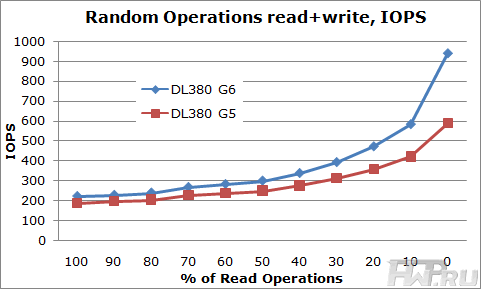
At higher write downloads, the advantage of DL380G6 increases, but throughout the test it is undeniable, as the following diagrams prove.


The DL380G6 performs better in both sequential reads and disk access times.
Well, it's time to summarize.
Conclusions
Depending on the configuration and additional options, you can purchase a 1-processor DL 380 G5 at a price of 1600 $ and more, and the cheapest DL 380 G6 will cost $ 2800 or more. Productive modifications with two 4-core processors, 12 GB of memory and 6 SAS hard drives will cost about 8 and 10 thousand dollars, respectively. The 20% difference on performance-class servers shouldn't confuse you. And if the question for you is whether to choose a server of the previous generation, but with a higher CPU frequency or a server of a new generation, which is also more expensive, then do not hesitate and choose the Hewlett Packard DL380 G6 , the overpayment is worth it.
This server, as our tests show, will be much faster in work, it is free of such drawbacks as vibration and high noise level. Built-in energy saving technologies make it more profitable to own. In addition, in networks using iSCSI, it will have to show the advantage of a hardware interface accelerator. Apart from the high cost, the only major drawback is the expensive RAID 6 activation on the controller. Otherwise, some pluses.
As for the DL380 G5, this server can still serve exactly in the minimum budget configurations , when the price comes first. In all other cases, the DL380 G6 is preferable.
Mikhail Degtyarev (aka LIKE OFF)
07/10.2009

